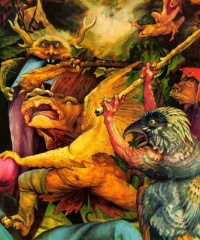Temptation of Saint Anthony in visual arts
From The Art and Popular Culture Encyclopedia
|
Related e |
|
Featured: |
The Temptation (or Temptations) of St. Anthony is a popular theme in the history of Western art. Many visual artists have depicted these incidents from the life of Saint Anthony as told in Life of Antony; in prose, the tale was retold and embellished by Gustave Flaubert.
Some of the stories of the demons and temptations that Saint Anthony is reported to have faced are perpetuated now mostly in paintings, where they give an opportunity and pretext for artists to depict their more lurid or bizarre fantasies. Emphasis on these stories, however, did not really begin until the Middle Ages, when the psychology of the individual became a greater interest.
Contents |
History
10th century
The subject of Saint Anthony was first presented in the 10th century at Italian fresco paintings. In the European Middle Ages one can watch an accumulation of the theme in book illumination and later in German woodcuts.
Middle Ages
About 1500 originated the famous paintings of Martin Schöngauer (ca. 1490), Hieronymus Bosch (ca. 1505) and Matthias Grünewald (ca. 1510).
- Isenheim Altarpiece
- The Temptation of St. Anthony (Bosch triptych)
- The Temptation of St Anthony (Bosch painting)
Early Modern
19th century
20th century and contemporary art
Dalí
Modern Spanish painter Salvador Dalí drew a great deal of inspiration from Bosch's work, which had many of the features that acted as precursors to Dalí's own surrealism. Dalí's version depicts St. Anthony resisting temptations associated with a spider-legged horse and elephants. The "space elephants," distorted offspring of Gian Lorenzo Bernini's elephant and obelisk, are a motif in Dalí's work.
See also


